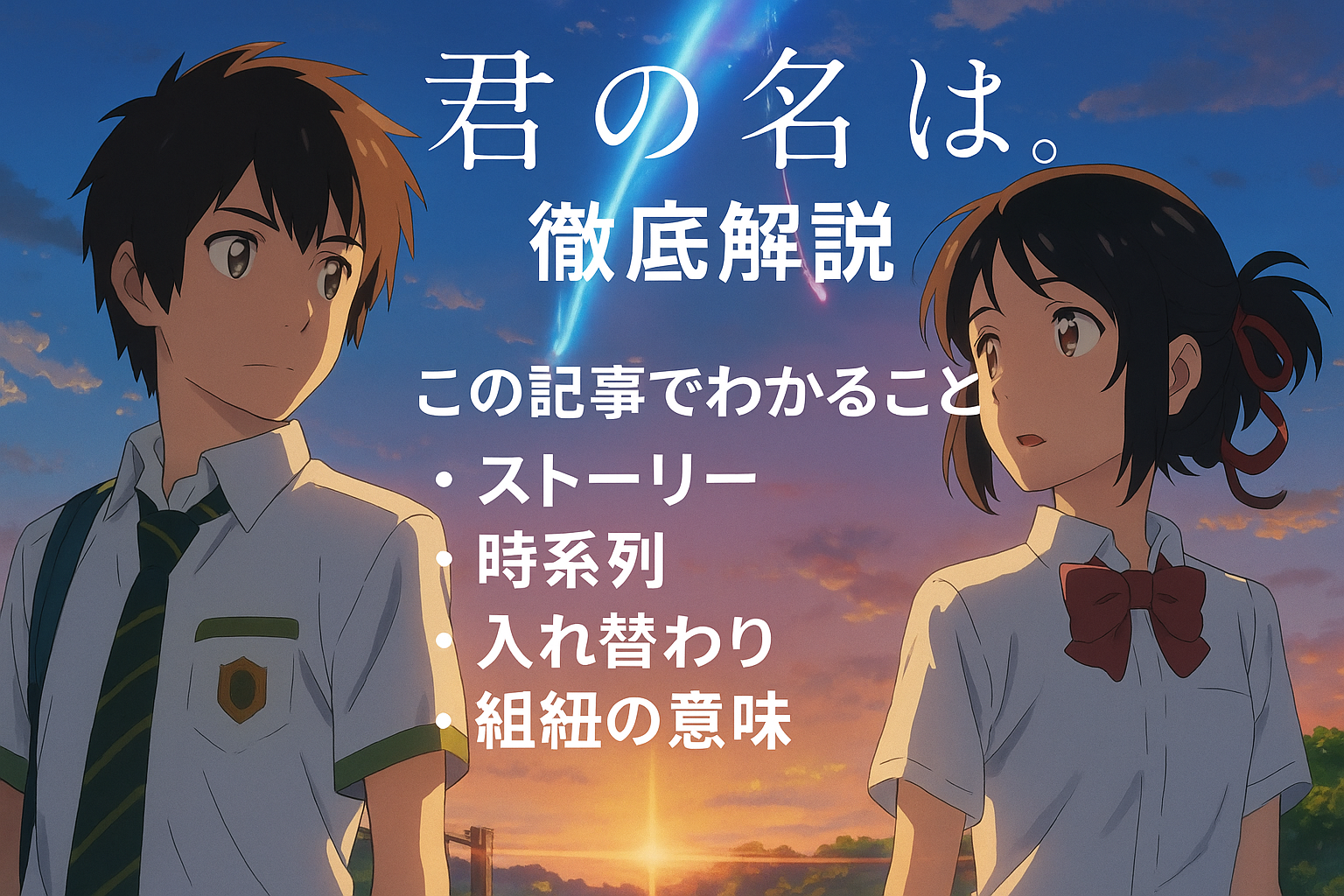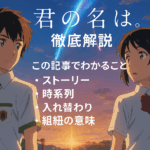※本記事にはプロモーションが含まれています。
- Explained the body-switching mechanics and timeline shifts in Your Name.
- Explored the symbolism of the comet, kagura dance, and kumihimo cords linked to the Miyamizu family’s fate.
- Revealed the emotional core: love that transcends memory and time.
- Highlighted the stunning visuals and how RADWIMPS’ soundtrack enhances emotional depth.
- Reported its record-breaking 19 million admissions and ¥25.17 billion revenue in Japan.
- Noted its $361 million global box office, placing it second among Japanese anime films.
- Answered common viewer questions to clarify the film’s complex plot.
- Provided updated streaming availability and free trial info.
- Showed why Makoto Shinkai’s work resonates as a timeless masterpiece.
- Clear explanation of the timeline and mysterious body-switching in “Your Name.”
- Insights into the comet, kumihimo cords, and the sacred fate of the Miyamizu family.
- Latest streaming availability and record-breaking box office performance.
- Introduction
- Understanding the Timeline and Body-Switching in “Your Name.”
- The Comet and the Miyamizu Family’s Fate — Symbolism in Kagura Dance and Kumihimo
- Why “Your Name.” Makes People Cry — Three Emotional Triggers
- Box Office Success and Worldwide Impact of “Your Name.”
- Frequently Asked Questions — Clearing Up Common Misunderstandings
- Where to Watch “Your Name.” — Streaming Platform Guide
- “Your Name.” in Review — Timeless Themes and Lasting Impact
Introduction
Makoto Shinkai’s animated film “Your Name.” has captivated audiences across the globe with its stunning visuals and emotionally resonant story.
At the heart of this movie lies a mysterious body-switching phenomenon between a high school boy in Tokyo and a rural girl living in a small town—raising profound questions about time, fate, and human connection.
In this post, we’ll explore the timeline twists, the symbolic layers of tradition and destiny, and decode the moments that leave so many viewers asking “What really happened?”
Understanding the Timeline and Body-Switching in “Your Name.”
“Your Name.” is not only visually breathtaking but also renowned for its intricate storytelling, especially the way time and identity intertwine between the two protagonists.
The key to the narrative lies in the body-switching phenomenon and the timeline gap that connects Taki and Mitsuha.
This section will help you understand these mechanics and the deeper themes they represent.
The story begins with Taki Tachibana, a high school boy in Tokyo, and Mitsuha Miyamizu, a girl living in the countryside town of Itomori, mysteriously swapping bodies through dreams.
At first, they both believe it’s just a strange dream. But when the swaps occur repeatedly over several days each week, they realize it’s actually happening.
What shocks them most is discovering that there is a three-year time difference between them.
Mitsuha exists in the year 2013, while Taki lives in 2016. Their connection is not only metaphysical—it crosses space and time.
This revelation becomes clear when Taki tries to find Itomori and learns that the town was destroyed by a comet three years earlier.
Devastated, he drinks Mitsuha’s sacred kuchikamizake at the shrine’s goshintai, and enters her body one last time to warn the townspeople.
This power is revealed to be part of the Miyamizu lineage—descendants of shrine maidens who have inherited the ability to transcend time as a sacred duty to prevent disasters.
Thus, the body-switching with its three-year gap is no accident—it’s a divine intervention meant to alter fate.
The film weaves the mechanics of this phenomenon into broader themes of time, destiny, and memory, leaving a lasting emotional impact on the audience.
The Comet and the Miyamizu Family’s Fate — Symbolism in Kagura Dance and Kumihimo
At the heart of “Your Name.” lies not just a love story, but a profound narrative of ancestral fate and ritual warnings of disaster.
Beneath its romantic surface, the film is deeply rooted in Japanese tradition, particularly through the roles of shrine maidens (miko), kagura dance, and kumihimo braided cords.
This section unpacks the symbolic meaning behind these cultural elements and their role in saving lives.
Mitsuha, born into the Miyamizu shrine family, performs kagura dance as part of sacred rituals passed down through generations.
One of the key elements in these rituals is the use of kumihimo, or traditional braided cords, which symbolize the flow of time, fate, and human bonds.
It’s later revealed that the intricate patterns in these cords represent Itomori Lake, the comet, and the twilight hour—not merely decorative, but coded messages from the past.
At one point, Mitsuha’s grandmother, Hitoha, explains, “These cords are the work of the gods. They represent time itself.”
This implies that the body-switching ability of the Miyamizu family exists to help prevent the comet’s destruction.
In other words, Mitsuha and Taki’s bond is not random—it’s a divine intervention to preserve history, passed down as a sacred responsibility.
Interestingly, Itomori has faced comet disasters before. The town’s folklore and rituals are in fact warnings preserved through symbolism.
The two red ends of the kumihimo represent the twilight hour, the blue center symbolizes the lake, and the red dot stands for the Tiamat comet.
This visual metaphor captures the delicate balance of past, present, and future—a hallmark of Makoto Shinkai’s storytelling.
Thus, “Your Name.” isn’t just a tale of star-crossed lovers, but a multi-layered narrative of mythology, legacy, and fate—an emotional experience that resonates deeply with viewers worldwide.
Why “Your Name.” Makes People Cry — Three Emotional Triggers
What makes “Your Name.” such a tearjerker? It’s not just a romance—it’s a sensory and emotional experience that hits you on multiple levels.
Let’s dive into the three key factors that stir emotions and leave audiences weeping.
First and foremost is the film’s breathtaking visual beauty.
Director Makoto Shinkai’s mastery of light, atmosphere, and background detail immerses you completely—from the shimmering twilight skies to the stillness of a mountain lake.
The comet scenes and the pivotal “twilight moment” are so visually striking that they can move viewers to tears even without dialogue.
Secondly, there’s the powerful synergy between visuals and music. RADWIMPS’ soundtrack enhances every emotional beat of the story.
Whether it’s “Zenzenzense,” “Sparkle,” or “Nandemonaiya,” each song is perfectly timed to the characters’ feelings and plot developments.
There are moments when the music alone—not even the dialogue—triggers emotional release.
Lastly, the theme of losing someone’s name—and with it, their very existence—strikes a deep psychological chord.
Even when Taki and Mitsuha forget each other’s names, they feel compelled to keep searching.
This bittersweet longing and fragile memory reflect universal feelings of love, loss, and hope—making it easy to relate and impossible not to cry.
In combining these elements, “Your Name.” becomes more than entertainment—it becomes a profound emotional journey.
No surprise then that it achieved over ¥25.1 billion in domestic revenue and $361 million globally—a record-breaking hit that touched hearts worldwide.
Box Office Success and Worldwide Impact of “Your Name.”
“Your Name.” wasn’t just a critical darling—it became a box office juggernaut both in Japan and internationally.
Its commercial performance redefined what an anime film could achieve in the global market.
Let’s break down the numbers and their significance.
Domestically in Japan, the film earned a staggering ¥25.17 billion (approximately $190 million).
This ranks it as the 4th highest-grossing Japanese film of all time, behind Studio Ghibli’s “Spirited Away.”
It also drew over 19 million moviegoers in Japan alone—becoming a full-fledged social phenomenon.
Globally, it brought in $361 million (around ¥41.4 billion), placing it as the 2nd highest-grossing Japanese anime film worldwide.
It became a blockbuster hit in countries like China and South Korea, proving that Japanese animation can command global audiences.
“Your Name.” offers a compelling answer to the question: What does it take for a Japanese film to succeed on a global stage?
Here’s a quick summary of its record-breaking numbers:
| Japan Box Office | ¥25.17 billion (4th highest ever) |
| Worldwide Gross | $361 million (2nd highest for Japanese anime) |
| Domestic Viewers | Approximately 19 million people |
With these figures, “Your Name.” didn’t just win over critics—it redefined the commercial ceiling for anime and inspired a new wave of creators and fans alike.
Frequently Asked Questions — Clearing Up Common Misunderstandings
While “Your Name.” is celebrated for its depth and emotional power, it also leaves many viewers scratching their heads with its layered storytelling.
Let’s address some of the most commonly asked questions to help clarify the film’s more puzzling moments.
Q1. Why did the body-switching suddenly stop?
Because Mitsuha died on the night of October 4, 2013, when the comet split and struck Itomori.
Her death severed the spiritual link, ending the body-switching. This loss drove Taki to search for her and ultimately attempt to change fate.
Many believe Mitsuha’s death served as the trigger that broke the supernatural connection.
Q2. Why did they forget each other’s names?
The memory loss occurred as the twilight moment ended, when time and space no longer overlapped.
Just as Taki tried to write his name on Mitsuha’s hand, time ran out, and she returned to her timeline without remembering it.
All she was left with was the phrase “I love you,” written in his place—a poignant gesture that speaks volumes.
Q3. Was the body-switching real or just a dream?
Initially dismissed as a dream, the phenomenon is later proven real through digital records, diary entries, and bodily evidence.
When Taki drinks the sacred kuchikamizake at the shrine, he experiences a final, intentional switch, confirming its supernatural authenticity.
Elements like the shrine, kagura dance, and kumihimo show that it’s a divine gift—an act of the gods, not imagination.
Understanding these key points makes the viewing experience more rewarding and emotionally resonant.
On a rewatch, you’ll likely notice layers of symbolism and foreshadowing that went unseen the first time.
Where to Watch “Your Name.” — Streaming Platform Guide
Years after its release, “Your Name.” remains a fan-favorite—and the good news is, it’s still widely available across major streaming platforms.
Here’s how to watch it affordably or for free, depending on your region and service provider.
Current Streaming Availability
| U-NEXT | Available to stream / 31-day free trial |
| Amazon Prime Video | Rental only / 30-day free trial |
| DMM TV | Streamable with points / 14-day free trial + 550 points |
| Netflix | Subscription-based / No free trial |
| Hulu Japan | Rental or subscription / 14-day free trial |
How to Watch for Free (or Almost Free)
Several platforms offer first-time user trials that let you watch “Your Name.” for free or at minimal cost.
- U-NEXT: 31-day trial + 600 points = Free or discounted rental
- DMM TV: 14-day trial + 550 points = Free viewing possible
- Amazon Prime: 30-day trial (rental fee applies separately)
If you’re trying to avoid paying full price, U-NEXT and DMM TV offer the best deals.
Tips Before You Stream
Note that services like Netflix do not offer free trials, so check your registration history before signing up.
Rental platforms often impose viewing windows of 48 hours, so be sure to plan accordingly.
If you plan to rewatch multiple times, subscription-based streaming (U-NEXT, Hulu) is the better long-term choice.
“Your Name.” is a film packed with visual and narrative layers, so rewatching is not only enjoyable—it’s rewarding.
Use a free trial to rediscover the emotions and mysteries of this unforgettable masterpiece.
“Your Name.” in Review — Timeless Themes and Lasting Impact
Released in 2016, Makoto Shinkai’s “Your Name.” has secured its place as one of the most influential and beloved films in Japanese cinema history.
It transcends the bounds of a simple love story by exploring themes of time, fate, memory, and spiritual connection.
This section offers a final reflection on what makes the film so special.
What truly sets “Your Name.” apart is its universality and emotional authenticity.
The idea of loving someone whose name you’ve forgotten, but whose presence lingers in your soul, resonates with people across cultures and languages.
It speaks to something primal: the desire to find “that person” who changes your life forever.
Behind that emotional resonance lies a deeply constructed mythos involving the Miyamizu family, sacred rituals, and the comet Tiamat.
Traditions like kagura dance and kumihimo cords aren’t just atmospheric—they’re central to the film’s internal logic and emotional payoff.
This adds an almost literary depth, making each rewatch reveal new layers.
We also can’t forget the film’s massive box office success: ¥25.17 billion in Japan and $361 million worldwide.
Its success proved that anime could dominate global charts, and inspired a new wave of international appreciation for Japanese storytelling.
It even sparked pilgrimage tourism to real-world locations featured in the movie.
In the end, “Your Name.” leaves you with the ache of longing and the beauty of human connection.
You may forget names and faces—but not the feeling that someone, somewhere is meant for you.
If you’ve never seen it—or haven’t in a while—now is the perfect time to rediscover it.



コメント